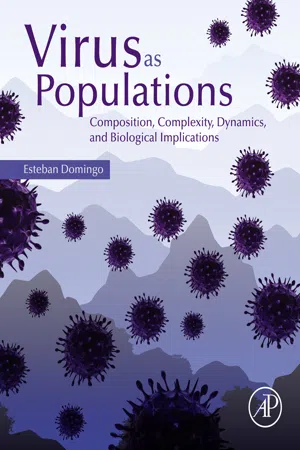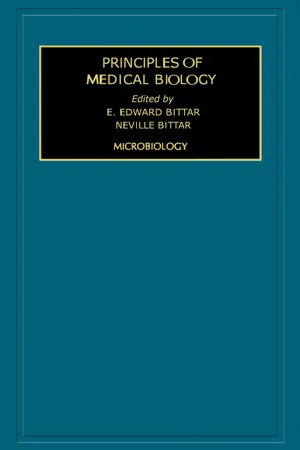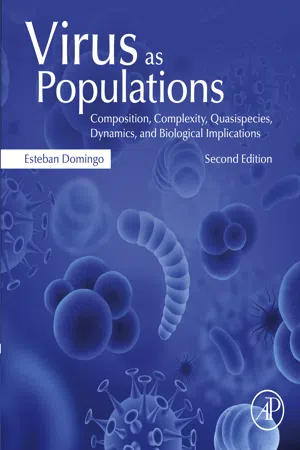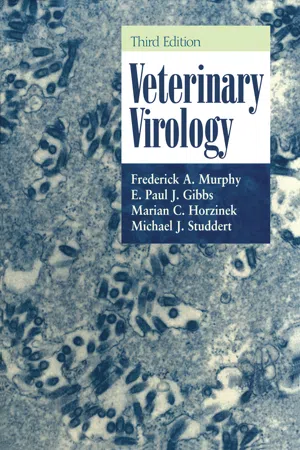Biological Sciences
Antigenic Drift
Antigenic drift refers to the gradual accumulation of small genetic changes in a virus over time, leading to the emergence of new strains. This process is particularly relevant in the context of influenza viruses, where it can result in reduced effectiveness of vaccines. Antigenic drift is a key factor contributing to the need for regular updates to flu vaccines to ensure continued protection.
Written by Perlego with AI-assistance
Related key terms
1 of 5
6 Key excerpts on "Antigenic Drift"
- eBook - ePub
RNA Genetics
Volume III: Variability of RNA Genomes
- Esteban Domingo(Author)
- 2018(Publication Date)
- CRC Press(Publisher)
III. Antigenic DriftAntigenic Drift describes the progressive change in antigenic properties which occurs with time after the introduction of a new subtype into the human population. Convincing evidence for the process is only available for human influenza, although there are suggestions that it may also occur in horses.13 Routinely, the changes in HA antigenicity are analyzed in hemagglutination inhibition tests using convalescent ferret antisera which are highly strain specific and show clearly the relationships between viruses isolated in different years.25 Recently, these analyses have been accompanied by studies of the nucleotide sequences of the RNA genes for HA of representative isolates26 , 27 , 28 , 29 , 30 and the results obtained indicate that Antigenic Drift results from the accumulation of amino acid substitutions in one of the two glycopolypeptide components of the HA subunit. Hemagglutinins are trimers of moleculai weight of about 220,000, in which each monomer consists of two disulfide-linked glyco polypeptides HA, and HA2 . The three-dimensional structure of the 1968 Hong Kong virus HA is known to 3 Å resolution.31 The molecule is a 135-Å-long cylinder, approximately triangular in cross section, and varying in radius from about 15 to 40 Å. The HA, chain of each subunit extends from the base of the molecule at the virus membrane through a fibrous stem to a distal region rich in β-structure and composed exclusively of HA, residues. It then returns to the fibrous region of the molecule and terminates about 30 Å from the virus membrane (Figure 1 ). The most prominent features of the part of the subunit composed of HA2 residues are two antiparallel α-helices, one, 29 Å long, which proceeds distally beginning about 30 Å from the membrane to connect with the other helix which is 76 Å long and stretches back to within 20Å of the membrane. These helices are the main components of the central fibrous stem of the molecule which supports the globular membrane distal HA1 - eBook - ePub
Virus as Populations
Composition, Complexity, Dynamics, and Biological Implications
- Esteban Domingo(Author)
- 2015(Publication Date)
- Academic Press(Publisher)
Villaverde et al., 1991 ). In this case, both time differences between transmissions and spatial heterogeneities would blur the transiently observed regularity.7.4 Long-term Antigenic Diversification of Viruses
Viruses can change their antigenic properties gradually, in a process termed Antigenic Drift, or suddenly, in a process termed antigenic shift. The distinction between Antigenic Drift and shift was established with IV (Gething et al., 1980 ; Webster, 1999 ; Parrish and Kawaoka, 2005 ). Shift in IV is due to genome segment reassortment that incorporates new hemagglutinin or neuraminidase genes. In monopartite viruses, the difference between gradual and drastic antigenic change has also been established (Martínez et al., 1991b ).The antigenic diversification of one FMDV serotype was examined over a six-decade period by comparing amino acid sequences of the major antigenic sites of the virus isolated in three continents (Martínez et al., 1992 ). The evolution of the capsid genes was associated with linear accumulation of synonymous mutations, but not of amino acid substitutions. Remarkably, the antigenic variation over six decades was due to fluctuations among limited combinations of amino acid residues without net accumulation of amino acid substitutions over time (Figure 7.5 ). This result suggests that constraints at the protein level may maintain a long-term virus identity at the antigenic level. In a related observation on the inter-host evolution of HIV-1 mentioned in Section 7.3.2 . HIV-1 recovered ancestral features when infecting a new host (Herbeck et al., 2006 ). Thus, multiple constraints in viruses may limit the rate and mode of long-term diversification, resulting in different numbers of circulating serotypes among related viruses.Figure 7.5 - eBook - PDF
- Edward Bittar(Author)
- 1998(Publication Date)
- Elsevier Science(Publisher)
In the other two diagrams the circles indicate the positions where prior changes had occurred and the triangles show the positions where additional amino acid substitutions accumulated during the indicated time periods. ing the strains which will cause future outbreaks and of selecting antigenically appropriate viruses for use as vaccines. Logic suggests that Antigenic Drift is driven by immune selection of changes in the regions of HA recognized by neutralizing antibodies. Although some changes selected will not be present in future outbreaks—an evolutionary dead end—others will become fixed in the HAs of viruses isolated from future outbreaks and define the lineage of Antigenic Drift. Explanations of how human populations can become reinfected year after year are incomplete since the HA does not normally change every year in all regions recognized by neutralizing antibodies. One possibility is that mutations in the different antigenic regions are selected sequentially because individuals in the population normally develop only partial immunity during infection (Wang et al., 1986). The neuraminidase glycoprotein, like the HA, participates in antigenic shift and undergoes rapid Antigenic Drift (Martinez et al., 1983; Colman et al., 1983). Sequence data on NA of isolates of the N2 subtype indicate that variation occurs predominantly in seven loops which have been identified in the crystal structure of the NA heads (Colman et al., 1983). Although anfibodies against NA do not inhibit virus entry into cells, they can offer some degree of protection against Viral Membranes 345 subsequent infection (Webster et al., 1988) by limiting the release of viruses from infected cells and hence the spread of virus from cell to cell. Analyses of the crystal structures of NA-monoclonal antibody Fab complexes have contributed extensively to understanding the molecular basis of antibody-antigen interactions. - eBook - ePub
Virus as Populations
Composition, Complexity, Quasispecies, Dynamics, and Biological Implications
- Esteban Domingo(Author)
- 2019(Publication Date)
- Academic Press(Publisher)
Villaverde et al., 1991 ). In this case, both time differences between transmissions and spatial heterogeneities would blur the transiently observed regularity.7.4. Long-term antigenic diversification of viruses
Viruses can change their antigenic properties gradually, in a process termed Antigenic Drift, or suddenly, in a process termed antigenic shift. The distinction between Antigenic Drift and shift was established with IV (Gething et al., 1980 ; Webster, 1999 ; Parrish and Kawaoka, 2005 ). The shift in IV is due to genome segment reassortment that incorporates new hemagglutinin or neuraminidase genes. In monopartite viruses, the difference between gradual and drastic antigenic change has also been established (Martínez et al., 1991b ).The antigenic diversification of one FMDV serotype was examined over a six-decade period by comparing amino acid sequences of the major antigenic sites of the virus isolated in three continents (Martínez et al., 1992 ). The evolution of the capsid genes was associated with linear accumulation of synonymous mutations, but not of amino acid substitutions. Remarkably, the antigenic variation over 6 decades was due to fluctuations among limited combinations of amino acid residues without net accumulation of amino acid substitutions over time (Fig. 7.5 ). This result suggests that constraints at the protein level may maintain a long-term virus identity at the antigenic level. In a related observation on the interhost evolution of HIV-1 mentioned in Section 7.3.2 , HIV-1 recovered ancestral features when infecting a new host (Herbeck et al., 2006 - eBook - PDF
- Frederick A. Murphy, E. Paul J. Gibbs, Marian C. Horzinek, Michael J. Studdert(Authors)
- 1999(Publication Date)
- Academic Press(Publisher)
Most of the changes are concentrated near the receptor-binding pocket at the center of the tip of the molecule. These sites include the two immunodominant antigenic sites, A and B, with fewer changes at sites C, D, and E. When the antibody, evoked by prior infection or vaccine, binds to epitopes in sites A and B, it can sterically hinder attachment of the virus to its cellular receptor. When the virus drifts, antibody specific for earlier virus strains no longer binds to these epitopes and the virus is free to cause infection, transmission chains, and epidemics. (From J. J., Skehel, D. C., Wiley, E., Domingo, J. J., Holland, and P. Ahlquist, eds., RNA Genetics. Vol. 3, p. 142. CRC Press, Boca Raton, FL 1988.) gesting that the change in virulence had been due to point mutations, i.e., to genetic drift. Previous studies had shown that virulence for birds is polygenic but that the hemagglutinin gene is of major importance. Sequenc- ing of the hemagglutinin genes from the April and Octo- ber isolates revealed seven nucleotide differences, re- suiting in four predicted amino acid changes in the hemagglutinin protein. One of these changes indeed re- moved a glycosylation site, thereby facilitating the cleav- age and activation of the hemagglutinin. The importance of this critical single nucleotide change may be measured 80 4. Viral Genetics and Evolution in practical terms: measures to control the epidemic and protect the poultry industry of the United States involved the slaughter of more than 17 million chickens at a cost of about $60 million. In August 1997, an H5N1 avian influenza virus not previously known to infect humans and without the intermediary cycle through swine infected humans in Hong Kong, four of whom died. The end of British rule in Hong Kong had resulted in the shipment of many chickens from mainland China to Hong Kong. - eBook - ePub
- David A. Baum, Douglas J. Futuyma, Hopi E. Hoekstra, Richard E. Lenski, Allen J. Moore, Catherine L. Peichel, Dolph Schluter, Michael C. Whitlock, David A. Baum, Douglas J. Futuyma, Hopi E. Hoekstra, Richard E. Lenski, Allen J. Moore, Catherine L. Peichel, Dolph Schluter, Michael C. Whitlock(Authors)
- 2013(Publication Date)
- Princeton University Press(Publisher)
In the 1990s, researchers began to use evolutionary phylogenetics to analyze influenza virus A isolates and track how successful lineages of the virus undergo Antigenic Drift —that is, specific changes in their hemagglutinin proteins that promote escape from human immune surveillance, allowing these strains to dominate subsequent flu seasons. Refinements of this approach are now used to predict which circulating strains are most likely to give rise to the dominant strains in the coming flu season, so that a vaccine against them can be produced and distributed before they become widespread. However, the effort to match the vaccine with the most important flu variants in a given year sometimes fails. These failures are most problematic when a new strain emerges through antigenic shift —that is, when recombination between virus strains generates a variant that escapes the immune system. Important goals of evolutionary medicine include more accurate forecasting of seasonal flu variants and better predictions of the emergence of new flu strains capable of spurring pandemics. The harm that a given pathogen or parasite causes to its host is often called virulence. An important fact is that virulence often differs markedly, even between closely related pathogens. Thus, another goal of evolutionary medicine is to understand how the virulence of a pathogen is shaped by natural selection. If a pathogen relies on direct transmission from an infected host to a susceptible host, then activities of the pathogen that might seem to increase its opportunity for transmission (e.g., greater within-host production of infectious particles) may weaken the current host and thereby actually reduce the probability of successful transmission. An extreme example would be a pathogen that kills its current host so quickly that a new host is not likely to be encountered
Index pages curate the most relevant extracts from our library of academic textbooks. They’ve been created using an in-house natural language model (NLM), each adding context and meaning to key research topics.





